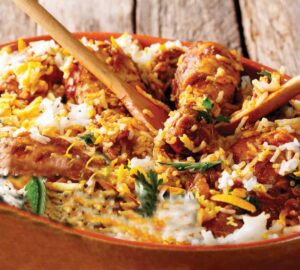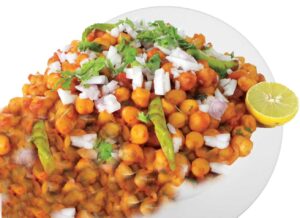By Anand Manikutty
In the previous column, we mentioned Josh Kaufman’s book The First 20 Hours: How to Learn Anything… Fast! Kaufman identifies 10 principles of rapid skill acquisition and 10 principles of effective learning. Since learning to cook involves both skill acquisition as well as knowledge acquisition, it would be appropriate to consider both sets of 10 principles here. We will consider the knowledge acquisition aspect of learning to cook Indian food. By investing a mere 20 hours in both the skill acquisition aspect and a further 20 hours in the knowledge acquisition aspect, we believe that one should be able to learn to cook some pretty decent Indian food. Although we have featured another royal recipe in this column, Hyderabadi Chicken Dum Biryani, we also have a much simpler dish, Chholey, which should be quite easy to prepare.
We continue with featuring displays of beautiful Islamic-style architecture also. Below, for instance, is the beautiful dome of the Hayat Bakshi Begum Mosque in Hyderabad which is where the first recipe comes from.
Kaufman’s 10 major principles for rapid skill acquisition are:
Choose a lovable project. 2. Focus your energy on one skill at a time. 3. Define your target performance level. 4. Deconstruct the skill into sub-skills. 5. Obtain critical tools. 6. Eliminate barriers to practice. 7. Make dedicated time for practice. 8. Create fast feedback loops. 9. Practice by the clock in short bursts. 10. Emphasise quantity and speed.
Each of these principles is so perfectly suited for the problem of learning to cook Indian food that they may as well have been written simply for learning how to cook Indian food. First off, choosing a lovable project. Have you ever wanted to learn to make chholey, or curried chickpeas? What about Hyderabadi biryani? How about curried pilaf? Each of these in and of itself would make for a lovable project. And the best thing is that it is possible to learn to make all of these dishes within the 20 hours you should allocate to the job of learning to cook some basic Indian recipes. Next, focusing your energy. When you are learning to cook Indian food, make sure you are focusing your energy on just this skill and any knowledge acquisition needed for this. Try not to be doing any other sort of skill learning while you are doing this. Another thing: what trips people up is that they either don’t have the knowledge or the skill set required. They therefore give up. Instead, if you pay close attention to spending enough time to garner both the knowledge and the skills, you should see good results.

To understand this better, a different example may be helpful. Consider learning to cook Middle Eastern food. We don’t know how to make baba ghanoush, but if we wanted to learn to cook Middle Eastern food, we would invest some time learning how to roast an eggplant in the appropriate way and also some time familiarising ourselves with the appropriate concepts in Middle Eastern cooking so that the dish tastes like something Middle Eastern. Thus, attention must be paid to both the knowledge acquisition as well as the skill acquisition aspect of learning to cook any cuisine, but it is not necessary to spend more than a couple of hours for this. Just go through a bunch of recipes of Indian food to get an idea of the common spices and other ingredients used there. This is the first point worth remembering.
It is also useful to keep in mind that there are likely to be both commonalities and differences between the way you usually cook and the way you would be cooking now. This is the second point worth remembering. Just as for Middle Eastern food, you might come across tahini or garlic more frequently than you would in, say, Chinese food, you will come across certain ingredients such as cumin powder, cinnamon and cloves more frequently with Indian food as well. You will come across some new cooking techniques as well. With those important points out of the way, and in keeping with the Islamic theme, here is a photograph of a small mosque from Hyderabad, which is another example of great Islamic-style architecture.
The third item in Kaufman’s list is about defining a target performance level. This is not difficult. Rather than try and make something that is of restaurant quality, we recommend that one should try making a dish that achieves about the same level of finesse as your other dishes that you already know how to make. So, if you have learnt how to make baked fish and it comes out a certain way, then try to match that quality. The fourth item is about deconstructing the skill into sub-skills. This can be important for complex, multi-stage dishes. Neither of the two dishes in this column is of that complexity. All you need to know is how to get a wok heated and how to identify the spices you will need. The fifth item is about obtaining critical tools. You know how a wok works, and you know how knives and spoons work. You just need to get yourself to the store and purchase the appropriate kitchen equipment. Don’t sweat the small stuff. What may be worth keeping in mind is that the process of preparing the spice base using oil or clarified butter as a base to a wok, and then adding spices such as mustard seeds, cumin powder and cloves is common to a lot of Indian dishes. I was introduced to this process as that of making Punjabi Masala, when I first learnt to cook, but we cannot know if that is the right term. The recipes in India are so old that perhaps it is best for you to fashion your own term for this. If you prefer, you can call this the Rajbhog Masala or even the Anand Masala. We are willing to volunteer one of our names for the purpose of identifying and demarcating this important first step that everyone trying to learn Indian cooking should get familiar with. In fact, Steps 4 through 8 in the Cooking Method for Chholey help you prepare exactly this very thing. The next five items are about time and workload management. Get yourself a copy of the book if you want to adopt more of Kaufman’s suggestions in this process of learning to cook Indian food, but they are actually not essential. You don’t have to hew close to the framework as far as learning to cook Indian food is concerned. We personally prefer to cook a whole bunch of dishes at one go, while taking extensive notes, so that we can fix any mistakes the next time. This approach has allowed us to keep improving our repertory of dishes so that they get better and better.
What may be worth keeping in mind is that the process of preparing the spice base using oil or clarified butter as a base to a wok, and then adding spices such as mustard seeds, cumin powder and cloves is common to a lot of Indian dishes. I was introduced to this process as that of making Punjabi Masala, when I first learnt to cook, but we cannot know if that is the right term. The recipes in India are so old that perhaps it is best for you to fashion your own term for this. If you prefer, you can call this the Rajbhog Masala or even the Anand Masala. We are willing to volunteer one of our names for the purpose of identifying and demarcating this important first step that everyone trying to learn Indian cooking should get familiar with. In fact, Steps 4 through 8 in the Cooking Method for Chholey help you prepare exactly this very thing. The next five items are about time and workload management. Get yourself a copy of the book if you want to adopt more of Kaufman’s suggestions in this process of learning to cook Indian food, but they are actually not essential. You don’t have to hew close to the framework as far as learning to cook Indian food is concerned. We personally prefer to cook a whole bunch of dishes at one go, while taking extensive notes, so that we can fix any mistakes the next time. This approach has allowed us to keep improving our repertory of dishes so that they get better and better.
So, that should be it. We hope these pointers get you started on cooking Indian food. First up is a recipe for Hyderabadi Dum Biryani. Next is a recipe for Chholey. Hope you enjoy making these dishes.
HYDERABADI CHICKEN DUM BIRYANI
Ingredients
0.5 kg chicken; 100 ml curd; 3 qts fried onions (2 now and 1 later); 25 gm coriander leaves; 25 gm mint leaves; 50 ml clarified butter; 3 tbsp chicken masala powder; 2 tbsp lime water; 2 qts cinnamon sticks; 3 qts green cardamom; 4 qts cloves; 1 tbsp hot spices powder; 1 tbsp cumin seeds; 1.5 tbsp salt; 1 tbsp turmeric; 2 tbsp red chilli powder; 2 tbsp coriander powder; 1 tbsp ginger-garlic paste.

Rice Preparations
0.5 kg Basmati rice; 2 qts cinnamon sticks; 6 qts black pepper; 3 qts green cardamom; 1 qts black cardamom; 5 qts cloves; 1 qts star anise; 1 tbsp ginger-garlic paste; 1 qts bay leaf;1.5 tbsp salt.
Other Ingredients
3 qts onion (ground); 1 pt wet wheat flour; 4 qts green chilli; 5 gm saffron; 20 gm clarified butter.
METHOD
To marinate the chicken
Step 1
Transfer the washed chicken pieces (with bone) into a bowl.
Step 2
Add curd, fried onions (2 tbsp), fresh coriander leaves, fresh mint leaves, clarified butter/ghee, chicken masala, lime water, cinnamon sticks, green cardamom, cloves, hot spices powder (garam masala), cumin seeds, salt, turmeric powder, Mathania red chilli powder, coriander powder, and ginger-garlic paste.
Step 3
Mix well till all the chicken pieces are nicely coated with the marinade mixture.
Step 4
Cover and keep in the fridge for 1 hour.
Step 5
Take out the marinated chicken from the fridge and let it sit on the kitchen top for 1 hour.
To cook the Basmati rice
Step 6
Heat water (1 litre) in a pot over medium-high heat.
Step 7
Add the cinnamon stick, black pepper, cardamoms (black & green), cloves, star anise, ginger-garlic paste, bay leaf, and salt. Also add the rice (washed, soaked in filtered water for 15-30 minutes, and drained) and clarified butter (1 tbsp).
Step 8
Stir all the ingredients into the water.
Step 9
Then let the rice cook undisturbed (for about 10 minutes) till it is 70% cooked.
Step 10
When the rice is 70% cooked, turn off the stove, drain the liquid, and keep the semi-cooked rice in a separate bowl.
To cook the chicken
Step 11
Place a wide copped pot or wok (kadhai) on the stove.
Step 12
Add the clarified butter and heat it for 1 minute.
Step 13
Add the onion paste and green chillies. Stir-fry over medium-low heat until it turns brownish.
Step 14
Add the marinated chicken along with the spice mixture. Add 1 glass of water (300ml) and stir-cook the chicken over high heat until the water evaporates and it releases oil.
To assemble the Hyderabadi Chicken Dum Biryani
Step 15
Reduce the heat to low. Take out half of the cooked chicken in a separate bowl.
Step 16
For the bottom layer, spread out the remaining half of the chicken in the pot.
Step 17
Add half of the semi-cooked rice and spread out evenly.
Step 18
Sprinkle 2-3 tablespoons of the fried onions, some fresh coriander leaves, and drizzle half of the saffron liquid (saffron strands soaked in lukewarm water for 10-15 minutes).
Step 19
Now, repeat the layering by adding the remaining half of the chicken, followed by the remaining semi-cooked rice.
Step 20
Finish off by sprinkling the rest of fried onions, fresh coriander leaves, and saffron liquid on top.
Step 21
Turn off the stove and attach the wheat dough across the pot’s rim.
Step 22
Cover with a lid and press gently to seal the pot.
Step 23
Turn on the stove again. Place the biryani pot on a flat wide pan (tawa) so that the biryani cooks on indirect low heat for 30 minutes.
Step 24
After that, turn off the stove and let the biryani sit covered for 15-20 minutes more.
Step 25
Finally, uncover the lid, remove the wheat dough, mix gently and serve.

CHHOLEY
• Chickpeas soaked, 1 cup
• Tomatoes, roughly chopped, 3 large
• Salt to taste
• Soda bicarbonate, a pinch
• Ghee, 3 tablespoons
• Roasted dried pomegranate seeds,
1 tablespoon
• Cumin seeds, 2 teaspoons
• Ginger-garlic paste, 2 tablespoons
• Dried mango powder, 1 tablespoon
• Red chilli powder, 1 tablespoon
• Garam masala powder, 1 tablespoon
• Coriander powder, 2 tablespoons
• Bay leaves, 2-3
• Asafoetida, 1/2 teaspoon
• Chhole masala, 1 tablespoon
• Ginger piece cut into juliennes,½ inch
Step 1
Put the chickpeas in a pressure cooker. Add five cups water, salt, soda bicarbonate and a tea bag. Close the lid and pressure cook for six whistles. Remove the tea bag immediately after the pressure is completely released.
Step 2
Heat one tablespoon ghee in a non-stick pan. Add tomatoes and cook for six to eight minutes. Add dried pomegranate seeds and cook for two to three minutes.
Step 3
Allow to cool and grind to a fine paste.
Step 4
Heat remaining ghee in a non-stick pan. Add cumin seeds. Once they crackle, add tomato puree and sauté for four to five minutes.
Step 5
Add ginger-garlic paste, mix well and cook for two to three minutes.
Step 6
Add dried mango powder, red chilli powder, garam masala powder, coriander powder, bay leaves and asafoetida.
Step 7
Cook for four to five minutes more.
Step 8
Add chhole masala and cook for five minutes more.
Step 9
Add the tomato puree to this masala (dubbed the “Anand Masala” in this column). Then, add the cooked chickpeas to this masala also. Serve hot garnished with ginger juliennes.
 (The author is a strategic management expert, economic historian, poet, Indologist, and a computer scientist. Currently, he is the editor of Termite, the journal of the Epimetheus Society, Top Society and a couple of other High IQ Societies.)
(The author is a strategic management expert, economic historian, poet, Indologist, and a computer scientist. Currently, he is the editor of Termite, the journal of the Epimetheus Society, Top Society and a couple of other High IQ Societies.)






